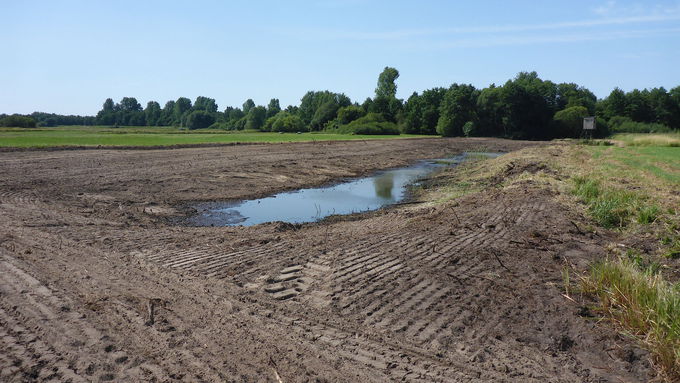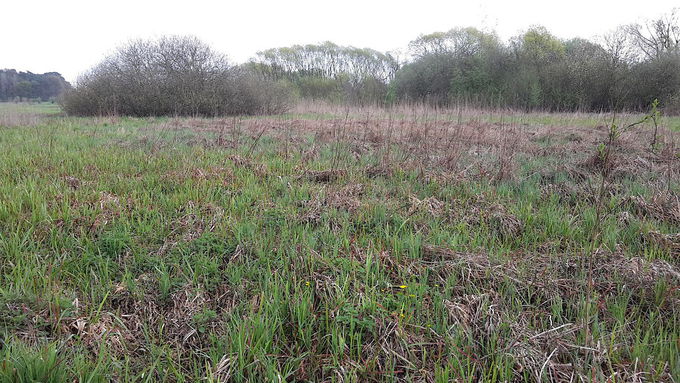One of the ponds after the optimization of its edges in summer 2018 © Hans-Martin Bröskamp, UNB Kreis Gütersloh
download picturemain content
Project of the month
OPTIMIZING THE HABITAT FOR THE MOOR FROG
Remodelling of ponds in the nature reserve ‘Rietberger Emsniederung‘
The wetland area ‘Rietberger Emsniederung’ in the district of Gütersloh was declared nature reserve with a size of around 440 hectares in 1989 as part of the wetland protection program of the state of North Rhine-Westphalia. Another 50 hectares large nature reserve, the former fish ponds ‘Rietberger Fischteiche’, adjoins this area. The open, spacious lowland landscape is divided by small natural copses, single trees, hedgerows and rows of pollarded trees. The characteristics of the wetland area also include a narrowly branched system of ditches and receiving streams which reflects the abundance of water in the landscape. The ‘Teichgut’ consists of a network of 26 small and large fish ponds which today are no longer used for breeding carp and tench. Both areas are part of the Special Protection Area (SPA) ‘Emsniederung bei Rietberg mit Steinhorster Becken’ under the European Union Directive on the Conservation of Wild Birds and have close functional relationship. Both nature reserves have a nationally outstanding importance for meadow and wading birds, species living in the reeds, grasshopper species living in wetland areas, as well as dragonflies and butterflies. The high proportion of wetland and wet grassland areas, partly being managed extensively and on bog sites, is habitat to a number of plants on the Red List. There are, for example, Eurasian curlew (Numenius arquata), black-tailed godwit (Limosa limosa), Northern lapwing (Vanellus vanellus), Western marsh harrier (Circus aeruginosus), gadwall (Mareca strepera), purple marshlocks (Potentilla palustris), bogbean (Menyanthes trifoliate) and yellow meadow-rue (Thalictrum flavum).
Noteworthy is also the population of the moor frog (Rana arvalis) which has its only occurrence in the district of Gütersloh within the SPA. It also represents one of the few populations in Ostwestfalen-Lippe. The moor frog mostly uses parts of the former fishponds as spawning waters; its terrestrial habitat is located in the adjacent meadows of the Ems lowland. In the past, agriculturally used wetland was the terrestrial habitat of the moor frog. After agricultural use has been widely discontinued, barely exploited or scarcely used wet fallows, reed beds and sedges have developed. Willow bushes and alders grow occasionally in the fallow land. Several marginal silted ponds, densely surrounded with shrubs, frame the project area. In the subsoil, boggy or half-bog soils with high levels of groundwater and non-stable turf occur. The management of the areas is based on contractual nature conservation, however the cutting and clearing is only possible with prolonged summer drought.
With the absence of regular agricultural use, trees and shrubs had spread noticeably in the border areas of the ponds. Shrubs growing on the edges of the ponds fed them each year with large amounts of leaves and wood and led to siltation. As a result, and due to the increasingly drier spring-times, the spawning opportunities for the moor frog disappeared. The aim of this action within the LIFE Integrated Project ‘Atlantic Region DE’ therefore is to improve the habitat of the moor frog by optimizing the ponds and to promote the species in this way.
Initially, the concept of this action also envisaged the construction of a new large spawning water. More than 1,000 cubic metres of excavated soil would have had to be transported out of the protected area. However, there was no possibility of handling the soil transport with heavy construction vehicles without prior development of an unpaved sand and grass way as construction road. In view of the high costs of such a construction road, the decision was ultimately made against the installation of a new spawning water.
In the same way, the plan to remove all shrubs from the ponds on the northern edge of the project area was abandoned. The works would have caused massive field damage to the adjoining non-public property so that the owner refused to use it.
After re-planning, the overall action was subdivided into works on the removal of shrubs (winter 2017/2018) and earthworks (summer 2018). Initially, in early September 2017, preparatory works were carried out in which the areas of the construction operations which were to be used to remove the wood were mulched. On the boggy soils, however, the first problems arose due to the heavy rainfalls: the mulcher got stuck at a particularly wet spot, but was easily retrieved by a second tractor. At other locations, the meadows on either side of the pond system had dried to some extent, allowing the logging to begin on the higher dam-like bank of the pond. In late autumn, the works had to be stopped indefinitely because the shrubs on the opposite bank of the pond and in the wet fallows were not accessible due to the wet conditions even for excavators with chain drive. Altogether, the shrubs were removed by winter on an area of around 5,900 square meters: existing trees around the ponds and a willow bush in the wet fallows were cut; the shrubs were cut back to the trunk and cut off just above the ground. In February 2018, finally two weeks of frosty weather set in, allowing the removal of the wood.
The dry and hot summer which already began in May then provided favourable conditions for carrying out the earthworks in this difficult environment. All tree and shrub stumps were removed in the course of the second part of the project in order to prevent reforestation and to permanently clear the project area of woody plants. Afterwards, three ponds were redesigned: upon their construction, the excavated soil had been heaped and levelled laterally on the eastern bank, resulting in the bank lying up to 80 centimetres above the mean water level. The edges of the ponds were now adjusted by removal of soil to almost the same height as the surrounding wetland area, the water’s edge flattened out and profiled close to nature. After less than four days, the company which is well versed in the implementation of landscaping and development measures had completed the works. When the construction machines left, a curious white stork was already exploring the remodelled ponds. They hopefully will develop into an attractive amphibian habitat and in the future provide optimal reproductive conditions for the moor frog again.
Further Links
- Nature reserve ‘Rietberger Emsniederung’ – Landesamt für Natur, Umwelt und Verbraucherschutz Nordrhein-Westfalen (in German) (external link opens in a new window)
- Nature reserve ‘Rietberger Fischteiche‘ – Landesamt für Natur, Umwelt und Verbraucherschutz Nordrhein-Westfalen (in German) (external link opens in a new window)
- Special Protected Area ‘Rietberger Emsniederung mit Steinhorster Becken‘ – Landesamt für Natur, Umwelt und Verbraucherschutz Nordrhein-Westfalen (in German) (external link opens in a new window)
- Lower Nature Conservation Authority of the District of Gütersloh (in German) (external link opens in a new window)





